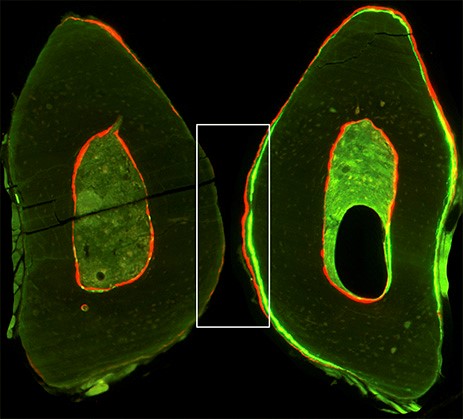Three-Time Foundation Funding Recipient Secures First R01 Grant to Further Research in How Bone Cells Respond to Mechanical Force
William R. Thompson, PT, DPT, PhD, was recently awarded a 5-year, $2.85 million award from the National Institute of Arthritis and Musculoskeletal and Skin Diseases (NIAMS).
The Foundation for Physical Therapy Research identifies and funds promising physical therapist researchers. These initial investments also help to prepare researchers to compete for external funding from larger research institutions.
In 2007, the Foundation awarded William R. Thompson, PT, DPT, PhD, a $5,000 Florence P. Kendall Doctoral Scholarship and later awarded him two $15,000 Promotion of Doctoral Studies II Scholarships, one in 2009 and another in 2010. Recently, Thompson expanded upon the Foundation’s investment and secured his first-ever R01 award from the National Institutes of Health (NIH) to continue his work.
At the time of his Foundation awards, Thompson wanted to learn more about how bone cells sense and respond to mechanical force. It has been a long-known scientific fact that applying force to bone leads to increased density or mass of the bone, while decreased force leads to bone impairments. What is not fully understood, is the process by which bones sense and responds to force. This is what Thompson set out to determine.
During his graduate studies, Thompson sought to understand how physical therapy interventions could reduce the debilitating effects of weak bones and joints in conditions such as osteoporosis and osteoarthritis. With an eye on patient care, he looked to design clinical treatments that effectively target bone decay. In his PODS II application, Thompson framed his research as a bridge to learning more about the appropriate frequency, duration, load, and intensity of therapeutic exercise.
It was this research that led to his most recent NIH R01 grant from the National Institute of Arthritis and Musculoskeletal and Skin Diseases (NIAMS). This 5-year, $2.85 million award will propel the work Thompson is pursuing to determine how bone cells respond to mechanical force. “This award is particularly meaningful to me, as the studies proposed in this R01 spawned from work that was funded in part by my PODS scholarships,” said Thompson. “As basic science research, such as molecular biology and transgenic mouse studies, are a rare pursuit in our profession, I was encouraged by the fact that the Foundation recognized the significance of this work in relation to rehabilitation and physical therapy. This forward-thinking mentality of the Foundation will undoubtedly lead to support of many more studies that leverage our understanding of molecular interactions to design novel therapeutic interventions for the benefit of our patients.”
According to Thompson, this project aims to understand how osteocytes sense and respond to mechanical force, allowing for better targeted treatments in patients where disease has led to bone decay. Osteocytes are bone cells that act as the primary mechanosensors in bone. Thompson also hopes to better understand the role of Gabapentin – originally designed as an antiepileptic drug, but most commonly used for neuropathic pain – which leads to increased bone fracture risk and diminished bone formation. “While the drug has been useful for nerve-induced pain, chronic use impairs bone formation; yet the mechanisms underlying these effects remain unclear.” Through his novel research, Thompson hopes to design improved exercise or pharmacological interventions to offset the negative effects of the drug ultimately reducing patient morbidity.
Thompson is an assistant professor within the School of Health & Human Sciences at Indiana University in Indianapolis. This grant represents the first R01 awarded within the newly-formed School of Health & Human Sciences, which was created in 2018 by the merger of two schools within Indiana University.
The Foundation has awarded more than $17 million in grants, scholarships, and awards to 560 researchers. These investments have yielded more than $804 million in follow-up funding.
Select Foundation Grants and Scholarships Awarded
WILLIAM R. THOMPSON, PT, DPT, PhD

